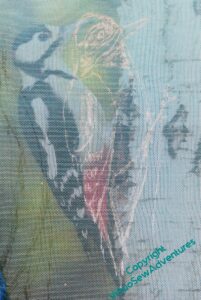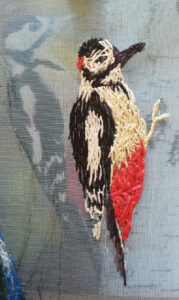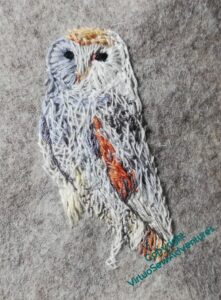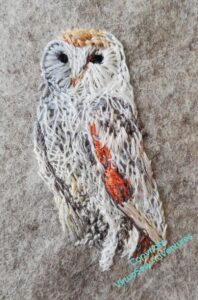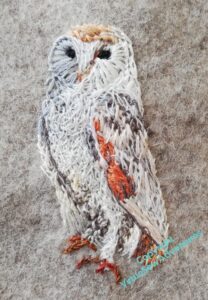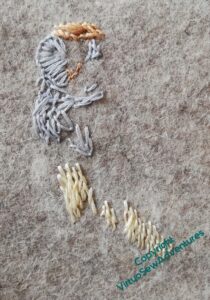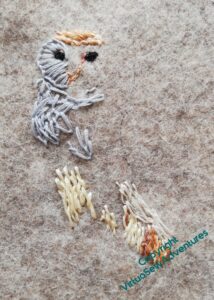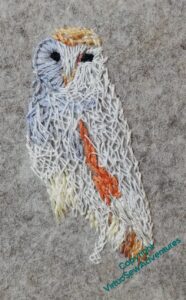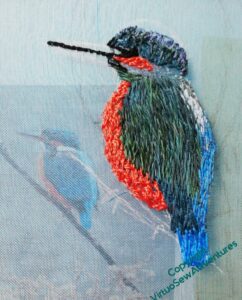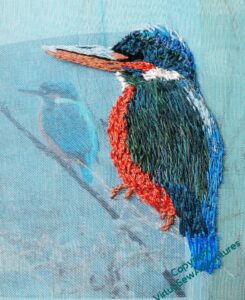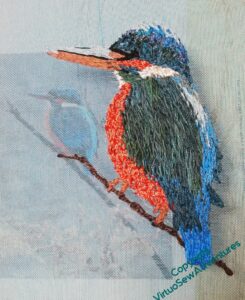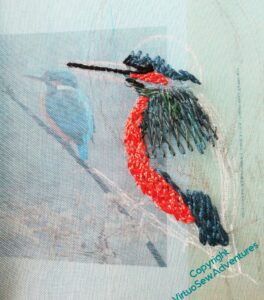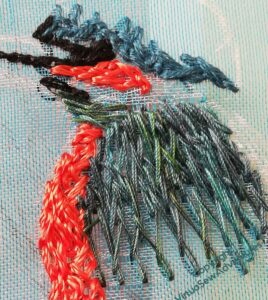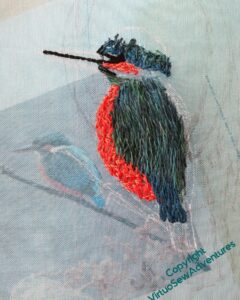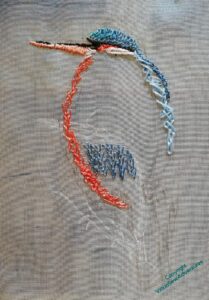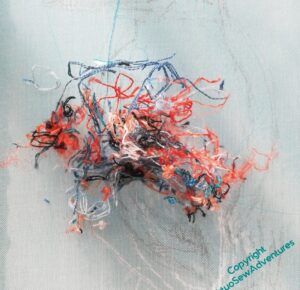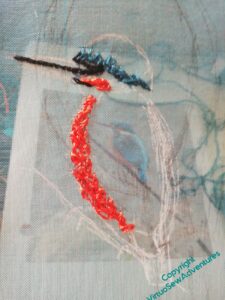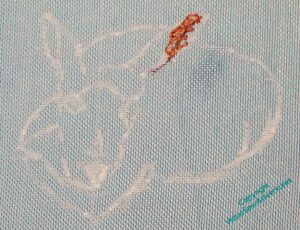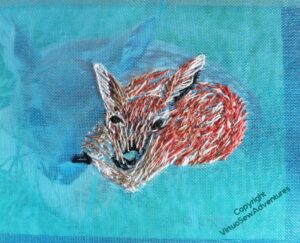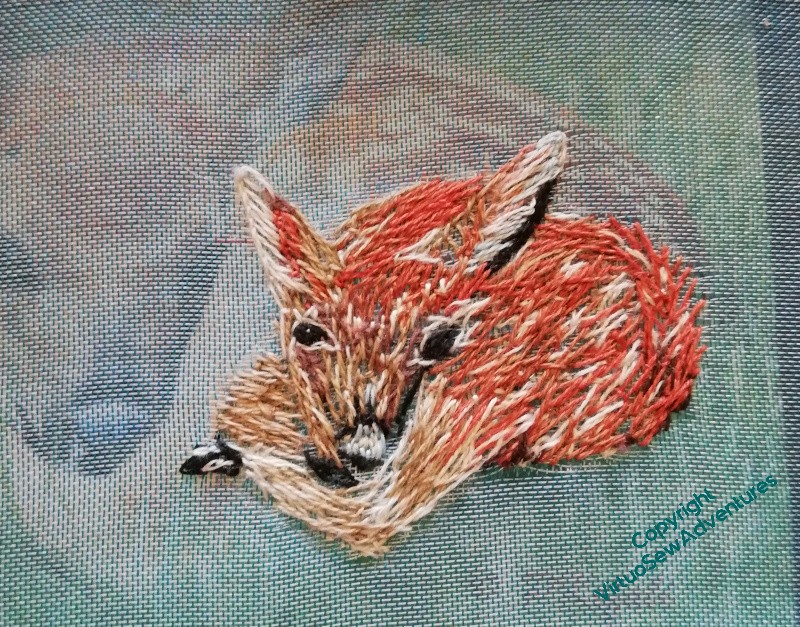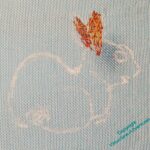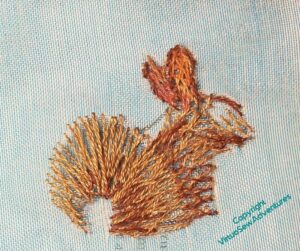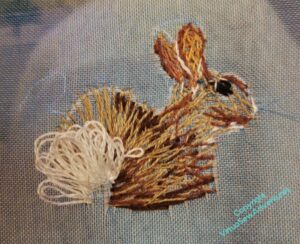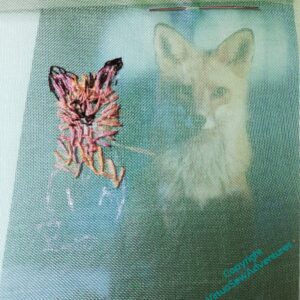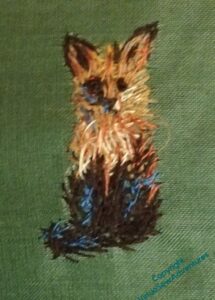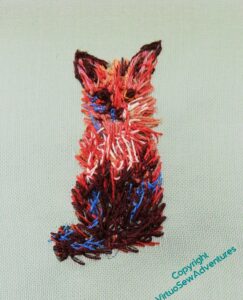Tag: Animal Vignettes
There’s going to be a woodpecker, too..
I am going to start rereading the book again, at some point soon, but in the meantime, since I’ve rediscovered my “Vision of Placidus” notebook, I know that one of the birds I was going to include is a woodpecker.
I’m going to have to go to the shops and find some more gauze soon, as well, but while I can squeeze an animal in to the existing fabrics, I will do so.
I’ve commented before, I think, that getting a readable and workable design drawing onto gauze is a non-trivial exercise, but this opaque white line (a Posca pen) is pretty much the best I’ve found so far, and it also allows me to help myself by putting a few extra emphases on the lightest parts.
It’s amazing how quickly these little animals go, once I have a chance to get started. In fact, I was so entranced by how Woody was growing that I didn’t stop to take photos. In fact, I barely stopped to draw breath.
So this photograph shows a single afternoon’s work. I’ve used mostly fine silk threads, although his red breeches are a soft perle, and some of the white is probably cotton. As for approach – I simply tangle my stitches together, feather stitch variations, Cretan stitch variations, the occasional chain stitch or straight stitch. What I’m hoping is that the tangle of stitches will create a subtle variation in colour that will help the whole thing feel alive when it’s viewed from a reasonable distance.

I didn’t have much I wanted to add, in the end. A few highlights, filling in the wings a little, and then really the woodpecker is done. I may add more when it comes to assembling the piece (remember all those seed stitches I added to the View of the Excavation once I started assembling the Dreams of Amarna panels?), but that can wait until I know what is being balanced with what.
I have been thinking, on and off, since I was asked about it after my talk, that assembling Placidus may prove to be an exceptionally challenging process. The panel I envisage is going to be about five foot by four foot, and I have a horrible feeling I’m going to be propping it against a wall or slinging it from hooks or even emulating one or other of the great Impressionists by somehow arranging a slot in the floor to drop it into while I tackle the top.
Maybe I shouldn’t be in too much of a hurry to finish this one…!
Finishing The Kingfisher
The kingfisher has been really quite tricky, but rewarding, too.
I do enjoy these colours, for a start, and the chance to use the really glossy rayon thread that helps his bright orange breast to shine. For the bright stripe of his back and tail, I’ve ended up combining threads in the needle to get just the colour I want. Even with a full range of Madeira stranded cotton in my thread stash, the precise colour and tone weren’t quite there. There’s another variegated mercerised machine thread in the mix as well – I think the motto for this piece is going to be “Whatever It Takes!”!
When I looked closely, I realised that the lower beak and the little claws were a very similar colour. The feet have been made a little scalier by stacking single twisted chain stitches atop one another so that they narrow into claws.
I’ve made the dark line of the beak narrower by bringing split stitches close in on either side, and done a lot of staring and adding little areas – the top of his head, the white flash at the side of the head, and the tiny bit of white at the throat. When I put him wherever he ends up, that will be one of the push-pull elements that helps him to detach sufficiently from the background to do his job.
Finally, I decided that the couple of bits of dark showing the underside of the far wing did in fact need to go in – more of the push-pull.
Then he wanted a twig to sit on. When I come to set him in place, I may cut some of the fabric close or turn it under, but other parts may be left so that the blue gauze modifies whatever is underneath. Some of this twig may be undone, some of it may be enhanced and extended.
I am reminding myself that I don’t work my best when I’m fretting about the Whole Thing. I do very much better when I get started and work out the whole thing later. I need to read the book again, to see whether there are particular animals I have to include. That will be no hardship, it’s a much beloved book!
I shall be giving a talk for the Embroiderers Guild on June 3!
I believe I’ve turned this image into a link to the Eventbrite page, and for anyone not in the right timezone, or otherwise occupied on the day of the talk, the Guild makes recordings available for some time afterwards.
I shall remind you every week until it happens!
The Kingfisher Continues
The kingfisher is proving more complex than some of the earlier animal vignettes. This is partly because the shape is complex, and partly, I think, because this is one of the elements I really want to include, so it’s hard to “play” quite so freely!
The lower stitching – part of the wings, maybe, or the tail? – is densely stitched in stranded cotton, and the head is small, tangled stitches again in stranded cotton. The original photograph that I’m using as a guide shows much smaller speckles of colour over the head, so the smaller stitches should help with that..
I’ve put a line down the beak which I need to make narrower as I stitch the rest of the beak, and I’ve started on the wing.
You can see in this close up that I’m using two strands of a variegated mercerised cotton for the wings, overlapping and tangling my Cretan Stitches to create something like the effect of the feathers. Considering that fluffy effect it has created for fur in some of the other Vignettes, I’m astonished and delighted that it’s not looking fluffy this time. The colour helps, of course, and the stitches are more closely packed, but still, I’d not realised until now just how versatile Cretan Stitch is!
I’m very pleased with progress so far. I need to find the right bright shade for that stripe down the back and the end of the tail, fit in his white collar, and the bright colour on the top of his head, and then work out how to keep the beak neat and crisp.
So far, that’s defeating me, so wish me success, please…!
A reminder that I shall be giving a talk for the Embroiderers Guild on June 3!
I believe I’ve turned this image into a link to the Eventbrite page, and for anyone not in the right timezone, or otherwise occupied on the day of the talk, the Guild makes recordings available for some time afterwards.
I shall (continue to) remind you every week until it happens!
And now for a kingfisher…
Many years ago – but after I first thought of doing a panel for the Conversion of Placidus – I went to a tour of Flag Fen, guided by Francis Pryor who had discovered and excavated it. As we strolled at the side of the fen, having much explained to us, there was a flash of bright orange, and a kingfisher shot across our bows. The effect, in glorious sunshine, with our minds in the Bronze Age, was absolutely electrifying, and I vowed that there would be a kingfisher in Placidus, somehow.
Of course, that’s easier said than done!
You maybe able to see in the first picture that I’d had two goes at drawing the Kingfisher, and started to embroider the larger one. I was intending him to be in the border, so I wanted him larger than a vignette. But that was not the way to do it, he’s too long in the body, and generally adrift. So I decided to go back to the first drawing, and not worry too much about leftover drawing.
It’s always sad to be unpicking, but once I’ve decided it’s necessary, I don’t repine, or even growl (much…). The next version will be better.
So I have started agin. The kingfisher’s breast is a tangle of overlapping feather stitch and feather stitch variation using Marlitt. It’s a good, vibrant colour, and I seem to have not had too trying a time with it, all things considered. Viscose threads such as Marlitt are very lively and twitchy, and if I want a smooth satin stitch, I try to damp out the kinks. For this, not so much, I want the light sparkling off the stitches, the speckles and high spots catching the light.
Well, it’s a start!
Now, a reminder that I shall be giving a talk for the Embroiderers Guild on June 3!
I believe I’ve turned this image into a link to the Eventbrite page, and for anyone not in the right timezone, or otherwise occupied on the day of the talk, the Guild makes recordings available for some time afterwards.
I shall remind you every week until it happens!
Finishing the Fawn
So, the Fawn…
Started, just like the rabbit, with a bit of pinky orange and a peculiar stitch choice (welcome to my world!).
Then I’ve continued, also just like the rabbit, by using Cretan Stitch, single strands, and some straight stitches. I’ve grouped some of the lighter stitches to help with the spots, I’ve put in the ears and hoof.
And the eyes. It does help, I think. These animals are being worked so freely, so approximately, if you follow me, that I need to find navigation markers to help me keep on track!
You will see that the finished Fawn isn’t quite right in all proportions, perhaps. The eyes aren’t balanced, and I’ve not managed to convey the narrow little face with its velvety fur.
But I’ve produced something that “reads” as a fawn, that is makes use of fabric and stitch, using the edges of blanket stitches to give me lines where I need them also to tie into the perpendicular direction. In a year’s time, I may come up with another way of doing this, but for now, I’m content.

Now – a very exciting thing! – I shall be giving a talk for the Embroiderers Guild on June 3!
I believe I’ve turned this image into a link to the Eventbrite page, and for anyone not in the right timezone, or otherwise occupied on the day of the talk, the Guild makes recordings available for some time afterwards.
I shall remind you every week until it happens!
Finishing the Rabbit
When we last saw Mr Rabbit, he was barely begun, just the ears with some interesting stitch choices.
Much of the stitching thereafter has been in varying random Cretan Stitch. I’m finding it quite useful for layering and intertwining the stitches around one another, each modifying the tone of the other. The gauze is also surprisingly useful, allowing the stitches to show through, modified once again by the colour of the fabric.
I’ve learnt from some of the first few animals and decided to put the eye in at an earlier stage. It’s not easy to get eyes entirely right, and if they are wrong it can look dreadful. As well as being harder to put in and harder to take out, the later it happens.
As I carried on, I put more layers of colour in, and then had the bright idea of doing the bunny’s tail in velvet stitch.
Of course I did.
I can tell you that pile stitch on gauze in single strands of stranded cotton is extremely fiddly and frustrating to do!
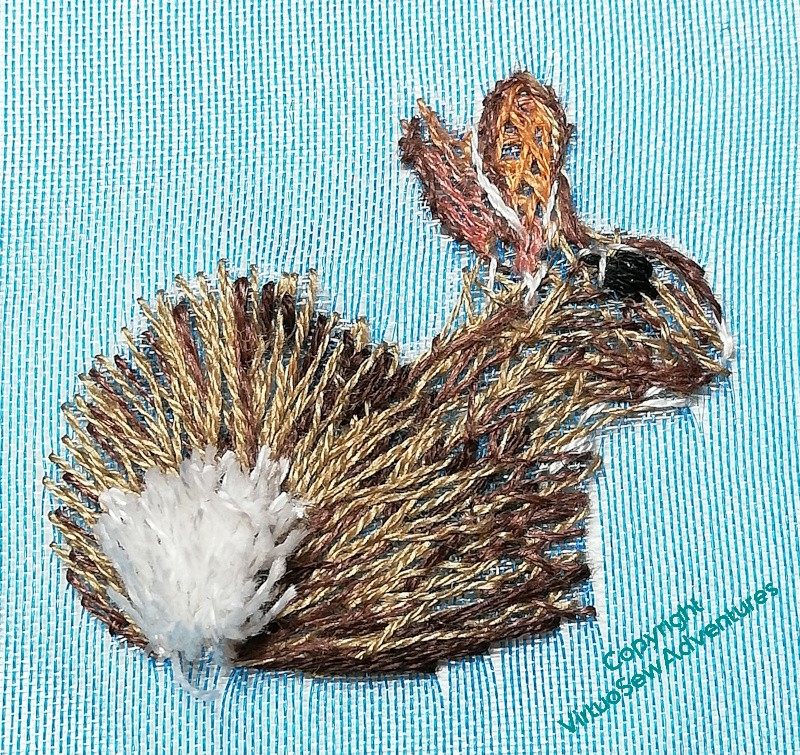
It works, though!
Starting More Animal Vignettes
Since I’ve decided to start on the animal vignettes for the Vision of Placidus, I’ve been making a hay while the sun shines, thinking of animals I want to include and finding picture sources. I do need to re-read the book to make sure I don’t miss out a critical element, but with Aethelflaed, Rahere, and the Lady Julian all swirling around in my head, a lot of research is also swirling around a bit, making it hard to keep things in order. However, while I have the gauze mounted on frames, I might as well keep going.
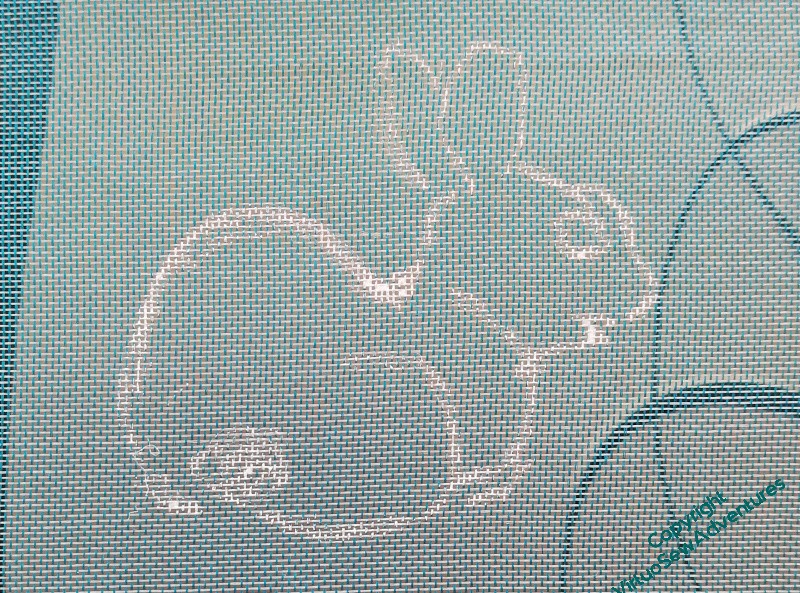
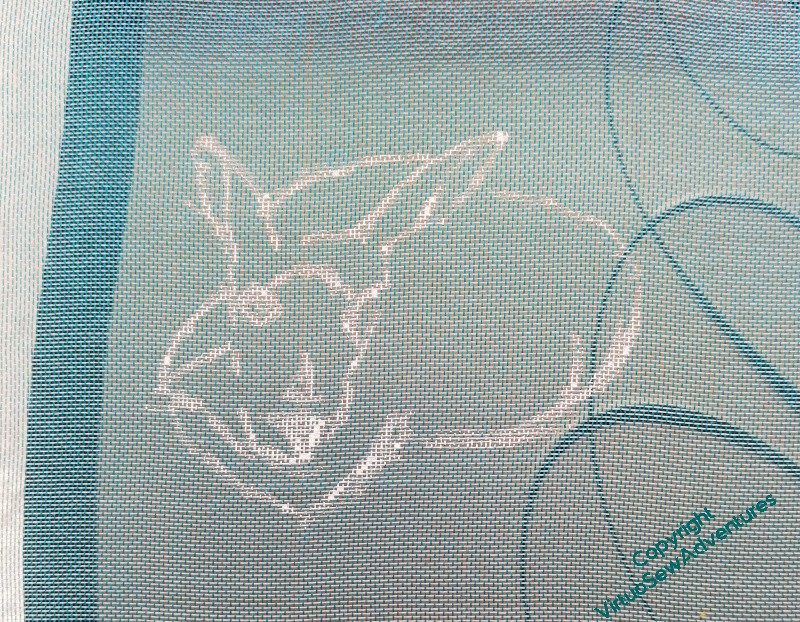
So here we have a fawn and a rabbit. The drawing is maybe not quite the success of the brockis, but it’s all so much stronger than it would have been two or three years ago that I’m taking merely the doing of the drawing as a huge success. I’ll probably keep on going on about this. At school, not only did I have no discernible skill with pencil and pen, I could make a biro blotch just by taking it in my hand. I’ve only really started to work on my drawing skills since late 2018, so when it works I’m almost indecently thrilled!
The sketches are side by size on the gauze, so I started thinking about them and working on them at the same time.
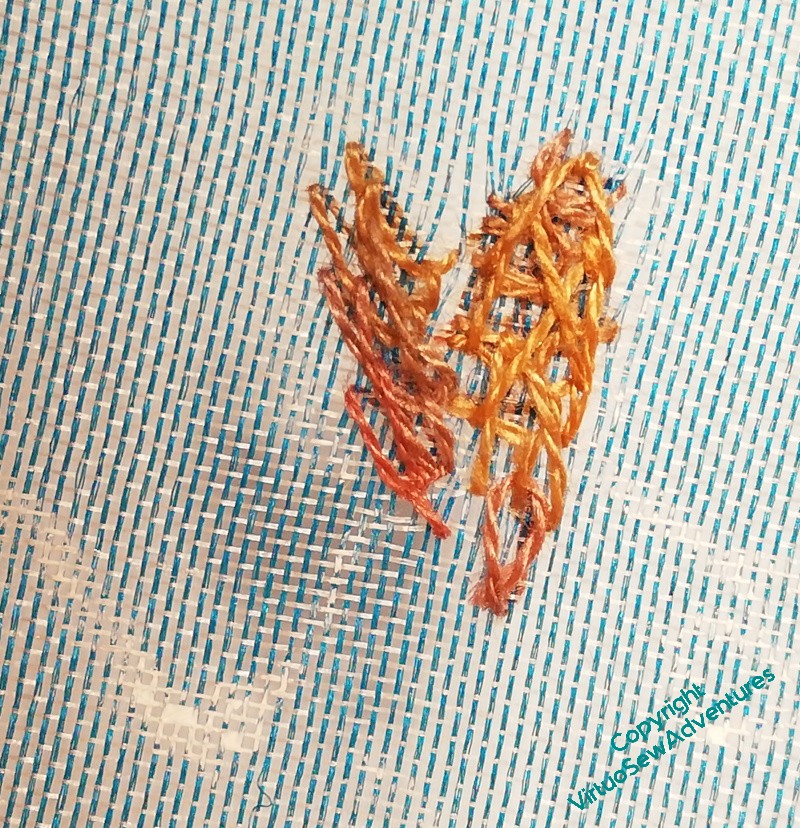
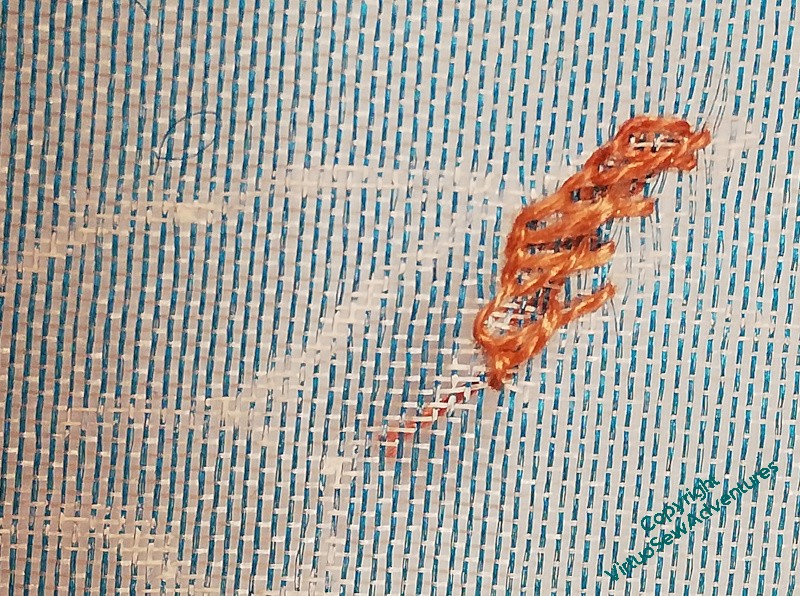
I probably won’t continue to give you quite such close ups, but I wanted to emphasise a few things about how this is beginning to come together in my head. The Medieval Movers and Shakers (William Marshall, Aethelflaed, Rahere, and Lady Julian) are going to be fairly strictly constrained to true Opus Anglicanum, split stitch and underside couching, and I will do that joyfully because it is part of my conception of them.
However – as I believe I may have said before! – my true love in embroidery is in playing with the texture and intricacy of thread and stitch. Even though it’s going to be a huge piece – I’m intending it to be five foot by four, at least – I want it to live and breathe my enthusiasm, in every detail and however closely you look at it. Each ear of these two has something slightly different about the fall of light and the way the lines and edges show, so I’ve tackled them slightly differently.
I’ve learnt from Mus’ Renard, and for now I’m using a single strand of stranded cotton (a Stef Francis variegated one, since you ask). I’ve used crossed blanket stitch in some places, because that gives me a thin line of the pinky-orange in a distinct area. And in the larger one of the two ears of the rabbit, I started with some fly stitches overlying each other. That gives some little shadows and helps everything come together with varying degrees of coverage.
Already this has changed from the Hawk, who was all in satin stitch to cover the gauze. I’m not trying to cover the gauze completely anymore – I’m already quite happy to allow the back to show through, just a little.
Mus’ Renard, Mus’ Renard…
This getting started on the animal vignettes seems to be working, for the moment.
I found a lovely picture of a fox staring straight out of the picture, so I’ve gathered russets and browns for this one. He’s awkwardly sized – maybe too big, when I finally get to the assembly of the panel – and I kept changing from one to two strands of stranded cotton and not being happy with either.
The half stage shows – rather blurrily, unfortunately – that I’ve used blue for the white-in-shadow. It’s amazing how often white does, genuinely, look blue or purple, but in any case, it helps to “lift” the general effect. When you’re mixing colours in painting, you can get lovely blacks and greys which have shades of other colours in them, and aren’t as deadening as straight lamp black would be. In embroidery, as I’ve said before, flat black has a tendency to unbalance a design, and in truth a lot of the greys aren’t much better. You might recall I turned Akhenaten’s black wig blue...!
Well, the gauze really does vanish under light, doesn’t it!
Some of the stitches had to be woven into to shorten the length of the colour on display, and I’m not as happy with Mus’ Renard as I was with the Brockis. But he looks much better from the distance that he’ll be viewed from than he does in analytical close up, and I have to regard at least some of these as studies for the final piece, rather than necessarily parts of that finished piece.
We’ll just have to wait and see…

